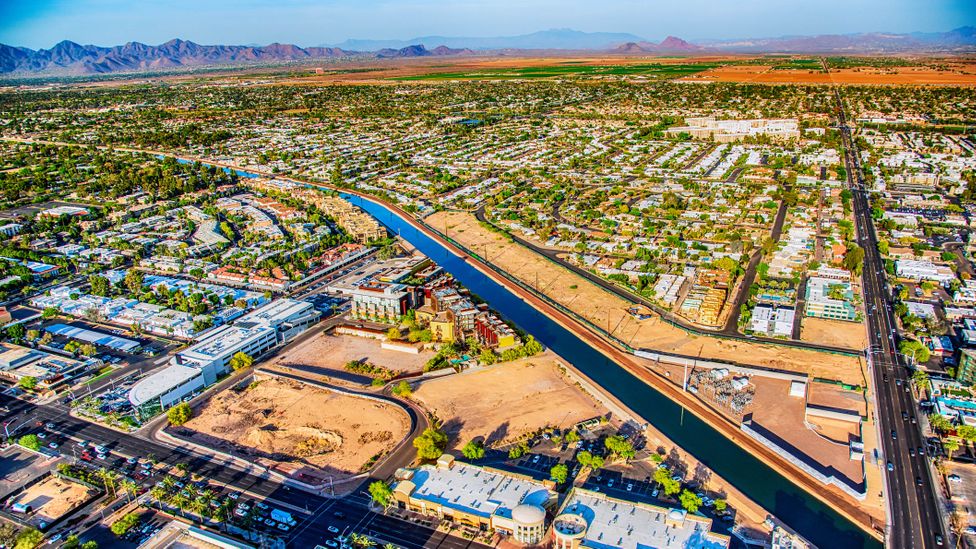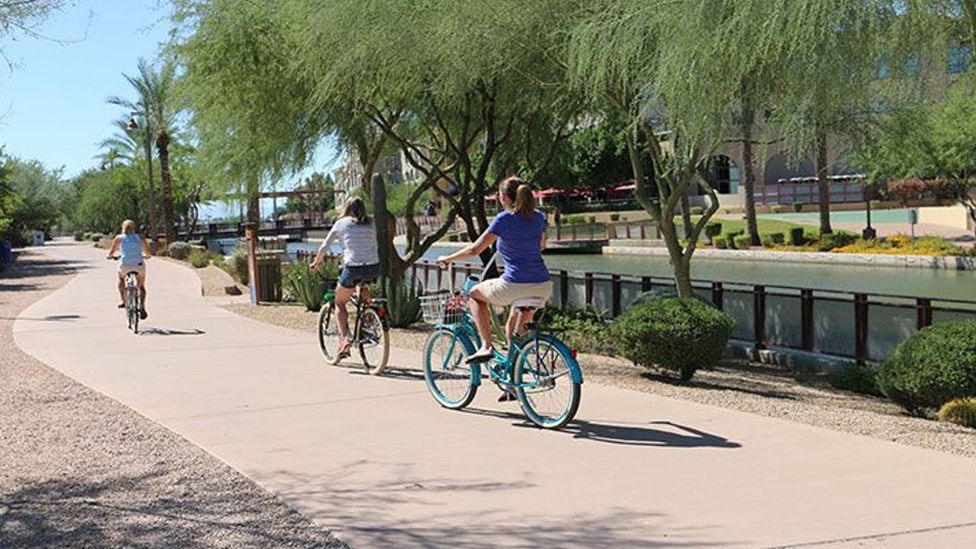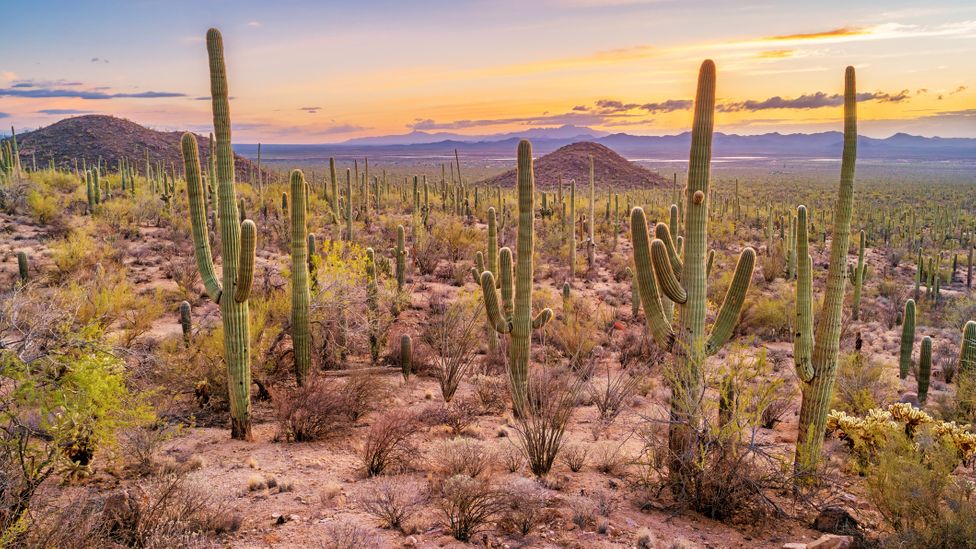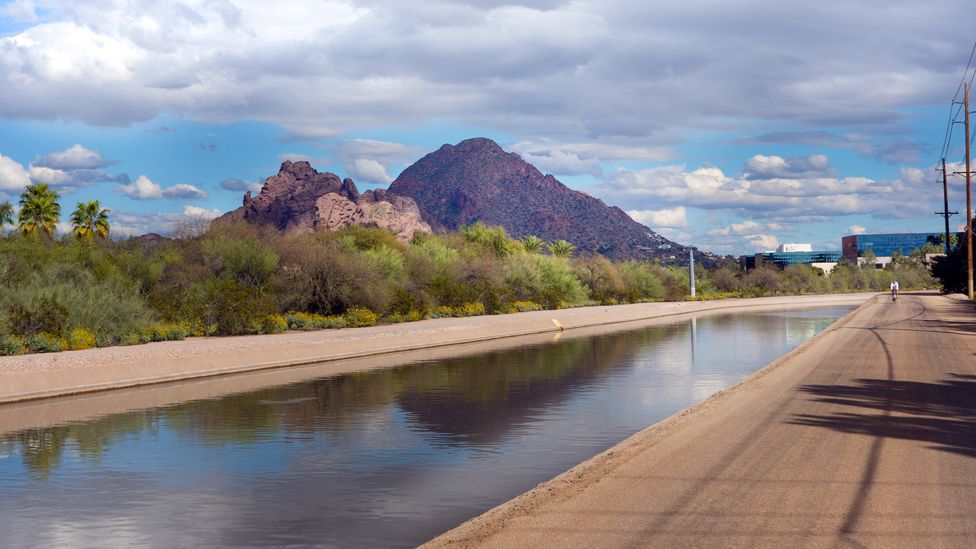Intro: Readers of this blog might like to visit the Arizona Museum of Natural History here in downtown Mesa. . .go indoors to escape toxic ozone pollution
BLOGGER NOTE: Phoenix & Maricopa County have some of the WORST Air Quality in the entire nation
-
The watery secret of ancient North America
Crisscrossing Phoenix, Arizona, are 180 miles of canals – more than twice as many as Venice and Amsterdam combined. As a native Phoenician, I've spent many hours bicycling their banks alongside joggers and fishermen casting for carp. I've joined wildlife watchers strolling the main Arizona Canal on a summer evening to watch Mexican free-tailed bats make a mass fluttering exodus from their roost. And I've chatted with long-time residents who fondly recall fashioning water skis from plywood, tying a tow rope to a pickup truck and jetting through their neighbourhoods in a spray of water and dust.
The canals deliver irrigation and drinking water throughout the metro area, allowing millions of people to live in this sun-baked desert. They are a major reason Phoenix exists, and the city's name hints at their mysterious origins.
In 1867, the city's founding father, Jack Swilling – a prospector who had fought on both sides of the Civil War – stood above the Salt River Valley and saw the remnants of irrigation channels squiggling across the landscape like stretchmarks. He realised that, centuries before, some society had farmed this desert. Soon after, Swilling began scouring out the debris-clogged ditches to bring agriculture back to the region.
Three years later, Swilling and other Anglo pioneers met to consider names for their settlement. The top contenders were Pumpkinville and Stonewall. Luckily, eccentric English adventurer "Lord" Darrell Duppa proposed a name inspired by the resurrection of the canals. "A great race once dwelt here, and another great race will dwell here in the future," he mused. "I prophesy that a new city will spring, phoenix-like, from the ruins and ashes of the old."

That great society was the Hohokam. Between 100 and 1450 CE, they constructed 1,000 miles of canals – the largest system of waterways in the Americas north of Peru. This sophisticated irrigation system harnessed river water and a meagre seven inches of annual rainfall and funnelled it to more than 100,000 acres of farmland. And they dug it all by hand with stones and sticks.
"The engineering is phenomenal," said Kathy Henderson, principal investigator at Desert Archaeology, an Arizona-based cultural resources management and research company. "We don't see a sequence where they start small. The canals are being built to scale as early as 500 or 600 [CE]. They must have been very attuned to how to transport water a long distance."
For Gary Huckleberry, a geologist and adjunct researcher at the University of Arizona, the water-wise Hohokam and their ancestors are still relevant today. "In the Southwest, we have some serious issues to deal with in terms of water," he said. "The Colorado River is the main source of water for the Southwest, and it's over allocated. You've got population growth and climate change. How are we going to deal with that? I think there's something to be learned by looking at past societies who managed water for thousands of years."

Many of the city's modern canals were constructed by retracing the Hohokam's handiwork (Credit: Salt River Project)
Native Americans have been building canals in Arizona for at least 3,500 years. The oldest waterways archaeologists have found date to 1500 BCE and diverted water from the Santa Cruz River in Tucson. Through trial and error, these ancient river people accumulated knowledge that was passed down from generation to generation, Huckleberry notes. "So, by the time you get to the Hohokam, they were skilled hydraulic engineers."
Today, the dammed Salt River is mostly dry in Phoenix. But visit the north-eastern outskirts of the city – where kayakers paddle the Salt past sienna mountains, cottonwoods and wild horses splashing along the shore – and you can sense the possibilities that greeted the Hohokam when they migrated here from southern Arizona. The Sonoran Desert is the world's most biodiverse desert. It provided ample plants and animals, in addition to the Hohokam's staple crops of maize, squash, beans and cotton.
Because the Hohokam had no draft animals, they carved the canals by hand using hafted stone hoes. With these simple tools, they created a precise downhill gradient of 0.3 to 0.5m every 1.6km. At the heart of the system, the Salt River, the channels started out large – more than 25m wide in some places. Then they slimmed as they branched into lateral canals and furrows, like watery arteries and capillaries writ large. These design features helped keep the flow at a consistent rate while minimising siltation and erosion.
As the Hohokam expanded their network, they had to contend with the area's complex topography. Multiple mountain ranges tower around and through metro Phoenix, making it, to my mind, the best big city in the world for hiking. But it's a challenge for hydraulic engineers, especially since epic summer monsoons dump rain that rushes along rock-hard surfaces. Floods would have regularly broken through headgates and filled channels with sediment, which meant the Hohokam constantly repaired, cleaned and diverted the canals. This necessitated a highly coordinated society.

The Hohokam were desert farmers, whose sophisticated irrigation system harnessed river water to bring agriculture to the region (Credit: Benedek/Getty Images)
"It requires cooperation, because all the users of the water from that canal have to agree not only to construct it, but also to maintain it," Henderson said. "An alliance of users would have to agree to certain conditions to keep the entire system going."
For example, she explained, not all farmers could open the gates to their fields at the same time, because some people further down the line wouldn't get any water. So, the Hohokam committed to sharing water and put themselves on timetables. "This led to the development of water rights," she added.
By the 13th Century, as many as 50,000 Hohokam people lived in villages that were regularly spaced along the canal system. This suggests to archaeologists that water and irrigation land was distributed fairly equitably amongst the community.
Over the centuries, the canal system was reorganised numerous times, but its essential structure remained the same. However, after 1300, the society and the canals began to diminish, and by 1450 the population had plunged.
No one knows why. Climate may have played a role, but there's no evidence of especially intense climatic events at the time. And though some irrigation-based cultures have faced salinisation of their soils, evidence indicates the Hohokam managed salt build-up well. While archaeologists once believed the Hohokam population collapsed following a catastrophe, improved techniques now point to a very gradual decline resulting from a complicated combination of community coalescence, flooding, siltation, reduced wild food resources and conflict.

The Grand Canal is getting spruced up as part of a project to connect Phoenix's east and west suburbs in a continuous multi-use trail (Credit: BCFC/Getty Images)
Still, Huckleberry says, there's much to learn from the Hohokam and their ancestors, who utilised canal irrigation for 3,000 years. "That, to me, is the definition of sustainable," he said. "They learned how to sustainably farm, to manage water, to not destroy their soils in a way that is commendable and might give us insight into how we might deal with the current plight. I think one of the key lessons is that you don't put all your eggs in one basket; you plan for the worst, and you diversify your strategies."
The Hohokam may have stopped managing their canal system, but they did not disappear. Their story continues with their descendants, the Akimel O'odham ("River People") and Tohono O'odham ("Desert People"), who live in central and southern Arizona today.
Their legacy also lives on in the city's modern canals, many of which were constructed by retracing the Hohokam's handiwork. The Grand Canal is now getting spruced up as part of a project to connect Phoenix's east and west suburbs in a continuous multi-use trail. "Today we are integrating the canals into our communities to improve neighbourhood access, add new public art spaces and contribute to a healthier Phoenix by introducing them as a recreational amenity," announced Phoenix Mayor Kate Gallego in 2020.
The Hohokam's heritage is also preserved in one of their villages, Pueblo Grande, a museum and archaeological park where visitors can see ballcourts, a platform mound (ceremonial house) and re-created adobe houses. Hikers can search for Hohokam petroglyphs of coyotes, mountain sheep and spirals along the trails of South Mountain Preserve and Deer Valley Petroglyph Preserve. And travellers can use the A Deeper Map app to swipe right on a modern map of Phoenix and reveal the Hohokam innovations hidden beneath their feet.
But perhaps one of the Hohokam's most important legacies is less tangible: the idea that it's possible – through cooperation, commitment and shared knowledge – to live sustainably in this sun-baked desert."
Ancient Engineering Marvels is a BBC Travel series that takes inspiration from unique architectural ideas or ingenious constructions built by past civilisations and cultures across the planet.
.jpg)
.jpg)
.jpg)
.jpg)
.jpg)
.jpg)
.jpg)
.jpg)
.jpg)
.jpg)
.jpg)
.jpg)
.jpg)
.jpg)
.jpg)


No comments:
Post a Comment